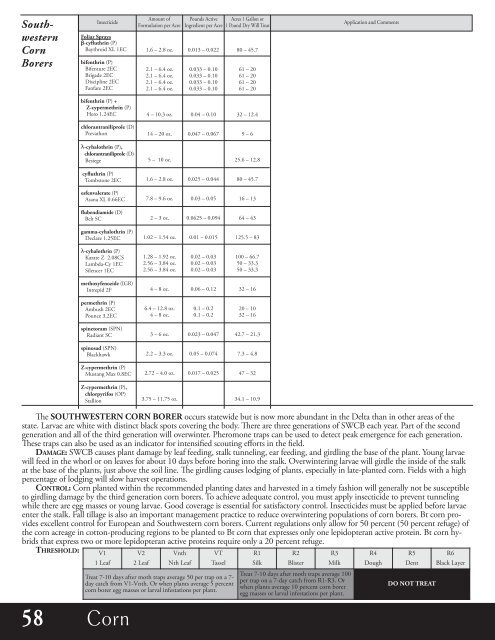Agronomic Crops
mJyPrJ
mJyPrJ
You also want an ePaper? Increase the reach of your titles
YUMPU automatically turns print PDFs into web optimized ePapers that Google loves.
Southwestern<br />
Corn<br />
Borers<br />
Insecticide<br />
Foliar sprays<br />
b-cyfluthrin (P)<br />
Baythroid XL 1EC<br />
bifenthrin (P)<br />
Bifenture 2EC<br />
Brigade 2EC<br />
Discipline 2EC<br />
Fanfare 2EC<br />
Amount of<br />
Formulation per Acre<br />
1.6 – 2.8 oz.<br />
2.1 – 6.4 oz.<br />
2.1 – 6.4 oz.<br />
2.1 – 6.4 oz.<br />
2.1 – 6.4 oz.<br />
Pounds Active<br />
Ingredient per Acre<br />
0.013 – 0.022<br />
0.033 – 0.10<br />
0.033 – 0.10<br />
0.033 – 0.10<br />
0.033 – 0.10<br />
Acres 1 Gallon or<br />
1 Pound Dry Will Treat<br />
80 – 45.7<br />
61 – 20<br />
61 – 20<br />
61 – 20<br />
61 – 20<br />
Application and Comments<br />
bifenthrin (P) +<br />
Z-cypermethrin (P)<br />
Hero 1.24EC<br />
4 – 10.3 oz.<br />
0.04 – 0.10<br />
32 – 12.4<br />
chlorantraniliprole (D)<br />
Prevathon<br />
14 – 20 oz.<br />
0.047 – 0.067<br />
9 – 6<br />
λ-cyhalothrin (P),<br />
chlorantraniliprole (D)<br />
Besiege<br />
5 – 10 oz.<br />
25.6 – 12.8<br />
cyfluthrin (P)<br />
Tombstone 2EC<br />
1.6 – 2.8 oz.<br />
0.025 – 0.044<br />
80 – 45.7<br />
esfenvalerate (P)<br />
Asana XL 0.66EC<br />
7.8 – 9.6 oz.<br />
0.03 – 0.05<br />
16 – 13<br />
flubendiamide (D)<br />
Belt SC<br />
2 – 3 oz.<br />
0.0625 – 0.094<br />
64 – 43<br />
gamma-cyhalothrin (P)<br />
Declare 1.25EC<br />
1.02 – 1.54 oz.<br />
0.01 – 0.015<br />
125.5 – 83<br />
λ-cyhalothrin (P)<br />
Karate Z 2.08CS<br />
Lambda-Cy 1EC<br />
Silencer 1EC<br />
1.28 – 1.92 oz.<br />
2.56 – 3.84 oz.<br />
2.56 – 3.84 oz.<br />
0.02 – 0.03<br />
0.02 – 0.03<br />
0.02 – 0.03<br />
100 – 66.7<br />
50 – 33.3<br />
50 – 33.3<br />
methoxyfenozide (IGR)<br />
Intrepid 2F<br />
4 – 8 oz.<br />
0.06 – 0.12<br />
32 – 16<br />
permethrin (P)<br />
Ambush 2EC<br />
Pounce 3.2EC<br />
6.4 – 12.8 oz.<br />
4 – 8 oz.<br />
0.1 – 0.2<br />
0.1 – 0.2<br />
20 – 10<br />
32 – 16<br />
spinetoram (SPN)<br />
Radiant SC<br />
3 – 6 oz.<br />
0.023 – 0.047<br />
42.7 – 21.3<br />
spinosad (SPN)<br />
Blackhawk<br />
2.2 – 3.3 oz.<br />
0.05 – 0.074<br />
7.3 – 4.8<br />
Z-cypermethrin (P)<br />
Mustang Max 0.8EC<br />
2.72 – 4.0 oz.<br />
0.017 – 0.025<br />
47 – 32<br />
Z-cypermethrin (P),<br />
chlorpyrifos (OP)<br />
Stallion<br />
3.75 – 11.75 oz.<br />
34.1 – 10.9<br />
e soUtHWesteRn CoRn BoReR occurs statewide but is now more abundant in the Delta than in other areas of the<br />
state. Larvae are white with distinct black spots covering the body. ere are three generations of SWCB each year. Part of the second<br />
generation and all of the third generation will overwinter. Pheromone traps can be used to detect peak emergence for each generation.<br />
ese traps can also be used as an indicator for intensified scouting efforts in the field.<br />
DAMAGe: SWCB causes plant damage by leaf feeding, stalk tunneling, ear feeding, and girdling the base of the plant. Young larvae<br />
will feed in the whorl or on leaves for about 10 days before boring into the stalk. Overwintering larvae will girdle the inside of the stalk<br />
at the base of the plants, just above the soil line. e girdling causes lodging of plants, especially in late-planted corn. Fields with a high<br />
percentage of lodging will slow harvest operations.<br />
ContRoL: Corn planted within the recommended planting dates and harvested in a timely fashion will generally not be susceptible<br />
to girdling damage by the third generation corn borers. To achieve adequate control, you must apply insecticide to prevent tunneling<br />
while there are egg masses or young larvae. Good coverage is essential for satisfactory control. Insecticides must be applied before larvae<br />
enter the stalk. Fall tillage is also an important management practice to reduce overwintering populations of corn borers. Bt corn provides<br />
excellent control for European and Southwestern corn borers. Current regulations only allow for 50 percent (50 percent refuge) of<br />
the corn acreage in cotton-producing regions to be planted to Bt corn that expresses only one lepidopteran active protein. Bt corn hybrids<br />
that express two or more lepidopteran active proteins require only a 20 percent refuge.<br />
tHResHoLD:<br />
V1<br />
1 Leaf<br />
58 Corn<br />
V2<br />
2 Leaf<br />
Vnth<br />
Nth Leaf<br />
VT<br />
Tassel<br />
Treat 7-10 days after moth traps average 50 per trap on a 7-<br />
day catch from V1-Vnth. Or when plants average 5 percent<br />
corn borer egg masses or larval infestations per plant.<br />
R1<br />
Silk<br />
R2<br />
Blister<br />
R3<br />
Milk<br />
Treat 7-10 days after moth traps average 100<br />
per trap on a 7-day catch from R1-R3. Or<br />
when plants average 10 percent corn borer<br />
egg masses or larval infestations per plant.<br />
R4<br />
Dough<br />
R5<br />
Dent<br />
Do not tReAt<br />
R6<br />
Black Layer


